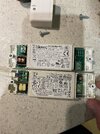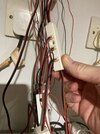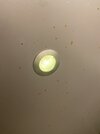- Joined
- 4 Nov 2024
- Messages
- 3
- Reaction score
- 0
- Country

Hi all,
First post here! But no doubt there’ll be a few more…
I searched but couldn’t find anything similar to this answered before.
We live in a new build (2012) block of flats - in the kitchen there are low voltage kitchen counter/shelf LEDs, numbering about 10 (it varies slightly by flat size) connected to a transformer hidden behind an access panel behind one the of cupboard backs. The lights are switched on via a standard (ie not dimmable) light switch.
My neighbours lights have recently gone uniformly dim, and I offered to have a look.
First visit- found the transformer, checked there weren’t any loose connections and checked the output from the transformer at 43v.
I guessed the transformer was at fault after 12 years of service so I bought an identical one.
Second visit- replaced the transformer and… exactly the same, all LEDs are uniformly dim. The transformer is plugged into a standard three pin socket, so I tried plugging it into another of the sockets on the kitchen, no change.
So what’s going on? The transformer doesn’t appear to have been the issue. My neighbour said the LEDs flickered a bit and went bright before going dim, which suggested some sort of power surge but I find that unlikely through a transformer.
Assuming there was a power surge, is it possible it could have damaged the LEDs in a uniform way? They’re all the same level of (not very) brightness. Is there a way I can test them?
Oddly the LEDs appear to be wired up in series which I wasn’t expecting, as removing any of the led plugs turns them all off.
Photos attached of transformers (original transformer below and replacement above) and plug/wiring behind access panel.
Any comments or suggestions gratefully received.
Cheers
First post here! But no doubt there’ll be a few more…
I searched but couldn’t find anything similar to this answered before.
We live in a new build (2012) block of flats - in the kitchen there are low voltage kitchen counter/shelf LEDs, numbering about 10 (it varies slightly by flat size) connected to a transformer hidden behind an access panel behind one the of cupboard backs. The lights are switched on via a standard (ie not dimmable) light switch.
My neighbours lights have recently gone uniformly dim, and I offered to have a look.
First visit- found the transformer, checked there weren’t any loose connections and checked the output from the transformer at 43v.
I guessed the transformer was at fault after 12 years of service so I bought an identical one.
Second visit- replaced the transformer and… exactly the same, all LEDs are uniformly dim. The transformer is plugged into a standard three pin socket, so I tried plugging it into another of the sockets on the kitchen, no change.
So what’s going on? The transformer doesn’t appear to have been the issue. My neighbour said the LEDs flickered a bit and went bright before going dim, which suggested some sort of power surge but I find that unlikely through a transformer.
Assuming there was a power surge, is it possible it could have damaged the LEDs in a uniform way? They’re all the same level of (not very) brightness. Is there a way I can test them?
Oddly the LEDs appear to be wired up in series which I wasn’t expecting, as removing any of the led plugs turns them all off.
Photos attached of transformers (original transformer below and replacement above) and plug/wiring behind access panel.
Any comments or suggestions gratefully received.
Cheers



